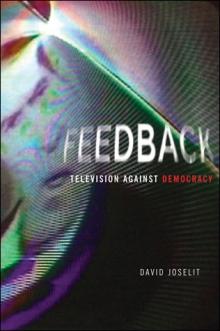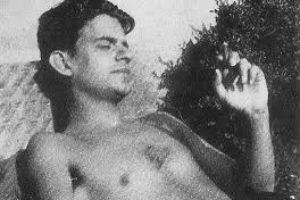Feedback: Television Against Democracy, by David Joselit
This review was published in The Journal of Aesthetics and Art Criticism, Volume 66, no. 1, pages 97–99, Winter 2008. A copy of the original can be downloaded here, or this post can be cited as: Buckner, Clark. “Television Against Democracy, by David Joselit.” www.clarkbuckner.com. Web. Date Month Year the post was accessed.
Histories of video art often begin with Nam June Paik’s disruptions of the conventions of television viewing in order to establish, first and foremost, that video is NOT TV. They then go on to address video art in art historical categories, as if its disciplinary complication of art, pop culture, technology, and mass-communication had been effectively neutralized. In Feedback: Television Against Democracy (MIT Press), however, David Joselit adopts the contrary tactic. He seizes upon the complicated nature of video as both a fine art and a commercial mass media to examine the politics of aesthetics. And he takes the work of early video artists, including Paik, Andy Warhol, Joan Jonas, and others, as the point of departure for critically engaging television, and re-thinking art history as a resource for activism.
What interests me most about Joselit’s study is the formulation of his problem, and the methodology he develops to address it. Joselit brings together the art historical dilemmas presented by the amorphous pluralism of contemporary art, and the confused state of politics since 1989 in which there seems to be no remaining vantage point from which to critique the institutions of capitalism and liberal democracy. Art historians, he contends, too often still rely on Marxist categories inherited from the Frankfurt School to explain the significance of artworks in quasi-revolutionary terms. Instead he “take(s) it as axiomatic that there is no longer a position outside capitalism in the United States, and that under such conditions, facile revolutionary claims for art (not to mention television) are little more than posing.” (p.30) Whether or not one entirely concedes the exhaustion of Marxist critical theory, Joselit’s argument finds further support in contemporary art. In its heterogeneity, the work of artists no longer stands strictly opposed to products of the “culture industry.” By bringing televisions into the gallery, Paik not only elevated video to an art form, he also corrupted the field of art with the paradigmatic consumer technology. And Warhol not only painted soup can labels, but also lent his talents to produce television commercials, and his name to endorse consumer goods. Not only is there no longer a clearly defined social horizon for resistance to capitalism; it may be no longer possible even to imagine a world altogether beyond the demands of commodity exchange.
Joselit contends this calls for a novel critical theory that would be both more true to the place of art in contemporary society and, in this honesty, re-invigorate the political possibilities articulated by artworks. Against the Frankfurt School’s concept of “reification,” which, he contends, reduces the commodity-form to an absolute stasis, he draws upon the works of Paul Virillo, Homi Bhabha, Arjun Appadurai, and others, to argue that the politics of contemporary culture would be better understood in terms of the tension between commodities and networks. He offers a synopsis of the structure of broadcast television, in which he outlines the mutual implication of the two, and argues that, while commodities coalesce networks (of information and social relationships) in apparently fixed objects, their co-implication also presents the contrary possibility, i.e., to dissolve commodities into the networks they otherwise stabilize. In the process, the commodity-form would be not altogether overcome but objects might be set in motion along new trajectories and infused with novel social significance.
At the same time, Joselit works to surmount contemporary disciplinary disputes between art history and the emerging field of visual culture, in which conventional, formal analyses of artistic productions are suspended in favor of considerations of commercial artifacts, new technologies, and modes of aesthetic consumption. He contends the terms in these debates are too fixed, and proposes to move beyond the opposition, central to them, between fine and commercial art, by re-conceiving the distinction between medium and media. Rather than the material substrate of artwork, Joselit follows Rosalind Krauss in thinking of “medium” in terms of the recursive, self-limiting conditions of cultural practices. And to define “media,” he appeals to Marshall McLuhan’s concept of “ratio,” as the dialectical effect that distinct technologies have on one another. Rather than simply distinguished, for Joselit, “medium” and “media” address the dynamics of inner and outer direction, which play complimentary roles in constituting the practices, audiences, and institutional frameworks of diverse phenomena. And he brings them together in his central concept, feedback, which he explains as the figure that arises from the interaction between medium and media.
Joselit conceives history on the model of television technology as “a scanned image whose apparent stasis is in constant motion – a fabric that at every moment is being undone and replenished.” (p.63) Accordingly, historical changes take place not through revolutions along a teleological path, but through interferences in the play of presence and absence that constitutes experience. And diverse fields do not stand simply segregated from one another, but help define one another through the dynamics of their interactions. He explains his art historical approach as an “eco-formalism,” in which the study of discrete images gives way to considerations of whole ecologies as the fundamental units of analysis; and yet the formal concerns of art history are not abandoned in favor of what would ultimately amount to sociology. Instead, he studies artworks alongside other cultural productions as disruptions, which resonate throughout these broader ecologies, by (re-) defining the fundamental dynamics of figure and ground that structure them as fields. “Art,” he contends, “stands against television as figure stands against ground, and television, in its privatization of public speech… stands against democracy.” (p. xi). Completing the hermeneutical circle, he then concludes: in this era of politics conducted largely through media-icons, democracy stands against the background provided by art.
Joselit’s interdisciplinary approach fills his book with analyses of richly diverse phenomena, which provide provocative compliments to one another, and together articulate aesthetic strategies for social and political change in ontological terms. Feedback is, for Joselit, a figure not only for aesthetic form but furthermore for politically sovereign subjectivity itself. His interest in television as an impediment to democracy concerns not the limited distortions it produces in the already established, empirical field of politics, as one might find in a piece of more conventional political science, but its role in constituting identities and communities as such. And he explores the work of artists not merely as potentially applicable to activism, but as the articulation of subject-positions fundamental to social and political life.
By transforming standard broadcast images into swirling colored lines, and constructing raging, over-saturated montages on walls of televisions, Joselit contends Paik reversed the dynamics of figure and ground in the structure of television viewing, and not only revealed new dimensions of the visual field, but disrupted “the nature of objectivity at its very roots.” (p.50) In this way, Joselit explains Paik’s video-works as inheritors of the ontologically destabilizing project inaugurated by Duchamp’s readymades. But he also connects Paik’s work to 1960’s counter-culture, and invests it with explicit social significance. He compares Paik’s videos to the ecstasies of psychedelic drugs, ties his techniques to the existential, political, street theater of Haight-Ashbury’s The Diggers, and traces a broader map of experiments in transforming social consciousness with expanded media, through work by Ken Kesey, Stan Brakhage, and others.
Similarly, Joselit argues that pieces by Bruce Nauman, Joan Jonas, Vito Acconci, and Peter Campus, tear figure and ground out of alignment, and render the video image conspicuous as a construct. The effect, he argues, is not a self-conscious opening onto reality, but rather the liberation of the image as a vehicle for forming identities – “as a process, not a televisual presence.” (p.163) And he takes issue with Rosallind Krauss’ now classical argument that video is fundamentally narcissistic. Instead, Joselit contends, “video’s medium is community;” insofar as constitutes the collective identities that provide the foundation for social formations. (p.105) On this basis, he provocatively explores Abby Hoffman’s and Andy Warhol’s respective engagements with media celebrity, and follows Huey Newton’s lead in tracing the figures of political agency in a film by Melvin Van Peebles. By engaging and articulating media identities, Joselit contends these three, in their distinct ways, were engaged in community building.
Joselit’s writing is lucid, and he works out a remarkably cohesive theory of art history, and the politics of aesthetics. The only significant problems I find with his book concern the substance of the matter, and my ultimate disagreement with the idealism of his position. If Frankfurt School Marxist’s recognized the importance of culture in constituting social formations, rather than dismissing it merely as an epiphenomenal superstructure determined by a material base; Joselit does away with considerations of material bases altogether. To speak in this way of ideal and material phenomena is perhaps to maintain the kind of theoretical distinction that Joselit generally works to dissolve. But, in his appeal to image and information networks, he decidedly collapses the opposition in favor of one of its terms. To his credit, Joselit acknowledges the need to consider the investments that inform distinct artworks and cultural practices; but this is the one promise of his methodology, which he does not make good on. He examines the structures of images, without reference to the social, psychological, and economic forces that produce them and sustain their enjoyment. So, while I found his analyses generally compelling, he did an injustice to political groups like the Black Panthers by treating them almost exclusively as “media activists” (p.144); and he claimed too much for the authority of images by arguing that they themselves constitute subject-positions and communities, rather than merely play an essential role in the process.
Joselit’s study also verges on abandoning critical praxis in favor of speculative synthesis. He employs his interdisciplinary strategies almost exclusively for the sake of comparison, without working out the disjunctions necessary to define the objects in question. For example, when he relates Paik’s video to 60’s counter-culture, he never questions whether counter-culture is a politically potent force, whether it is in fact progressive, or whether it is an instrument and effect of dominant institutions. What about the contrary example provided by the merging of artist’s video and counter-culture with the development of MTV in the 1980’s? Didn’t this instead mark a further refinement in the commodity form, as popular songs were reduced to soundtracks for their own advertisements? And what about contrary examples from the history of video art? In the end, Joselit offers fairly conventional readings of canonical, early, artist’s video, which indeed maintained a dissonant opposition to mass culture. But has it continued to maintain this dissonance, as it has emerged as a predominant art form? To the contrary, doesn’t much video art – including work by Pipilotti Rist, and Mathew Barney – further extend the spectacles of consumer culture into the museum? The tendency to relinquish critique in favor of speculative synthesis may be a danger in interdisciplinary studies, insofar as they might seem to allow one to shift focus before establishing the intra-disciplinary contrasts that would give an object concrete determinacy. But, in the context of Joselit’s study, it seems more like a further effect of his idealism. When one supposes that artists and activists can cause “a public to flash into being with feedback,” (p.131) the success, failure, and actual character of those publics cease to be concerns. And the critic is free to map an open-ended field of possible analogues.
In the end, I wonder how one might take into consideration the role of material conflict in social formations, and avoid these speculative tendencies without thereby compromising the significant accomplishments of Joselit’s excellent book.




